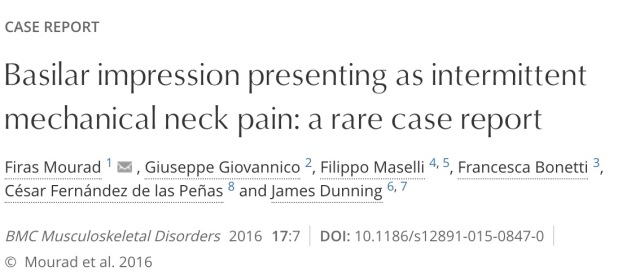
Seems like I’m on a roll here with case reports on upper cervical spine screening lately! Just deal with it, it’s an interest of mine
I do enjoy reading these as can be great learning experiences to reflect on, especially considering something as serious and rare pathoanatomical conditions do not walk in your door everyday.
This open access case report comes from a friend of mine & one of AAMT’s own, Dr. Firas Mourad. He and colleagues present an excellent report on clinical reasoning for individual with basilar impression. Interesting that Hoffman’s test was negative, but clinical reasoning led to performing a modified Sharp-Purser Test to decrease symptoms (which will be the positive sign). This is the appropriate procedure as the test is not intended to provide a mechanical input that could make symptoms worse, which is the purpose of other upper cervical spine instability tests (i.e. anterior translation test). Actually the initial Sharp-Purser is just cervical flexion with a description of modified Sharp-Purser usually shown in a neutral spine, but Dr. Mourad performed in cervical extension; which was the provocating cervical movement in this case.

I have not had the time to watch the entire 2 hr lecture yet, but wanted to share as this was passed along by a colleague of mine, Dr. Eric Jorde. The research and updates in pain science is remarkable and videos like this have helped me understand more and more as a clinician treating pain everyday.
As always, looking forward to your input.
You can see original post and all prior posts at http://intouchpt.wordpress.com
Harrison Vaughan, PT, DPT, OCS, Dip. Osteopractic, FAAOMPT
Interested in live cases where I apply this approach and integrate it with pain science, manual therapy, repeated motions, IASTM, with emphasis on patient education? Check out Modern Manual Therapy!
Keeping it Eclectic...













Post a Comment
Post a Comment